
Unfortunately, Internet Explorer is an outdated browser and we do not currently support it.
To have the best browsing experience, please use Google Chrome, Firefox, Microsoft Edge or Safari.
We use cookies to improve your experience on our website. By continuing to browse this website, you agree to our use of cookies. For more information, please refer to our privacy policy.

This is a self-funded case study using our Advertising Testing solution.
Over the past 4 years, Captain Risky has become synonymous with the Budget Direct brand. His humorous antics have both amused and delighted Australian audiences, while succinctly conveying the message that Budget Direct saves you money on your insurance.

More importantly, he has become one of the most powerful branding devices used in Australia. Branding devices help to connect advertising memories to a brand on a subconscious level, without the need to overtly shout it out. Think about Compare the Market’s Meerkats, Snicker’s strapline: “You’re not you when you’re hungry” and Red Bull’s cartoon ads. Branding devices such as Captain Risky are one of the most important – albeit underutilised – levers for driving advertising effectiveness. In the quest to create new and original work – often driven by a new CMO or agency that wants to make their mark – these can be hastily disposed of.
Budget Direct recently went to air with a familiar message (“Get award-winning cover for less with Budget Direct”), but with an all-new cinematic approach. The campaign introduced viewers to Detective Sarge, who seeks to unravel the mystery of why people would inexplicably pay more than they need to for their insurance. The campaign was headlined by a 2min 30sec TVC that went to air during primetime television; an event in itself which is worth celebrating, given the investment in creativity and long-term fame-building communications is unfortunately becoming increasingly rare.
The crime-thriller mystery was one of the most unique and distinctive TV ads that we’ve ever tested at Cubery, eliciting emotions such as amusement, amazement and excitement. The suspense and drama-filled narrative – combined with a decent dose of humour – engaged viewers and had them questioning whether they were watching a movie-trailer or ad.
“It was like a mini movie and kept you in suspense till the end”
“It was like a very short movie with an actual plot theme able to keep my attention, much different to many ads”
While creativity and originality are important elements for getting noticed, it goes without saying that a clear and relevant role for the brand is essential for it to have a commercial impact. And it is in this respect that ‘Detective Sarge’ missed the mark. Extremely weak branding was a function of Budget Direct being easily interchangeable in the narrative with any other brand from any other category – let alone insurance. The absence of any unique assets connecting it back to Budget Direct in an unmistakable way further compounded this problem.
“I would never have guessed the brand”
“Looked like an ad for a bad tv show”
The difficulty viewers had connecting the ad to Budget Direct was also related to the complex and layered narrative, with many people left scratching their heads wondering how it all fitted together and what it was trying to say about the brand. As a result, “none” was the strongest spontaneous association people were left with about Budget Direct after seeing the ad.
“I had absolutely no idea what the hell it was all about. When I saw it last night it really could have been about anything. When I saw it today I feel exactly the same”
“Hard to make sense of product, far too long, too much happening”
Regardless of the channel or platform being used to connect with your audience, it’s an extremely difficult task getting people to remain interested and engaged with your content for two-and-a-half-minutes. In order to do so, a succinct and entertaining story with a clear and compelling message about why people should choose your brand is required. ‘Detective Sarge’ unfortunately failed to do this, and as a result the ad achieved a Cubery Rating of 49 (a prediction of the brand and business impact of the ad), placing it in the bottom 30th percentile of our TV database for creative effectiveness.

Want to test your own advertising, packaging, or product ideas? Cubery combines a team of creative effectiveness experts with cutting-edge technology, bridging the gap between creativity and commercial impact. Get in touch to learn how we can unlock growth for your brand.
